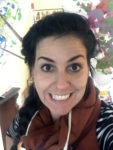
Nature. It gives us everything we need to survive. Some remote civilizations still live solely by what they can sow, hunt and make from the ground they live on. Our prehistoric ancestors were knowledgeable in what we could utilize from Mother Nature. Trees gave shelter and were used to create places to dwell, plants and flowers helped heal ailments and relieve pain, berries and nuts were harvested for eating. Animals were a source of food and clothing, their bones even utilized for making needles to sew with. The earth was there to grow crops, make pots for storage, create baskets from reeds and even produce pigments to paint with. We used what it offered and in turn respected its magnificence.
It is easy to forget what our local surroundings offer us when it comes to creating with your children. In an age of synthetic paint brushes let us take a moment and remember that our ancient relatives used items in their surroundings to create with. Paintbrushes were made from animal hair and wood, many are still made from these materials.
Today we will be exploring the concept of Mother Nature Paintbrushes. What can be used to paint within your garden or parks? The answer is pretty much anything!

Mark Making. What is it?
When you talk about mark making in response to a piece of painted art, you refer to how the paint has been applied. They can be dots, line, patterns, textures and so on. Mark making can be done on any material that has a surface, so from a canvas to a clay pot to a piece of fabric. Those studying art history are taught to learn to distinguish pieces of art through the mark making. This means an artist’s work can be recognized simply by examining the way the paint has been applied to the canvas. Each painter has a unique way they apply paint.
Do you have a family member whose handwriting is very distinctive? So if you get mail from them, you know exactly who it is from without having to open it? Art experts that work on old paintings done by famous artist’s, read the marks (paint strokes) to reveal who has painted them.

Some painters in the late 18th and 19th century used mark marking as a tool to convey to the viewer how they were feeling when creating that particular painting. For example, Vincent Van Gogh (1853-1890) when painting some of his self-portraits, were made from vicious, thick lines that give the viewer a sense of discomfort, hysteria, and chaos (see Self-Portrait with Grey Felt Hat, 1887, Van Gogh Museum, Amsterdam). While other self-portraits done by him have more discreet strokes of paint and give a more calm, melancholy image (see Self-Portrait, 1889, Musée d’Orsay, Paris).
Talking to your children about mark making
Mother Nature Paint brushes is the perfect platform for introducing the concept of mark making. Each of your nature paint brushes will leave a mark on your paper in a slightly different way. Test out each one and see how they look. Do they look the same? Different? Which mark do they prefer? Which is easiest to paint with?

Getting started.
| Nature We Used
Feathers |
Other Suggestions
Pinecones |
What you will need:
- Any plant you can find in nature that is long enough to be tied together and used as a paintbrush
- String
- Scissors
- Paint
- Paint palette
- Paper or sketchbook

Instructions:
- Go with your children outdoors and pick a few different types of plant. Have a few of each item so those that need extra strength can be tied together.
- Cut string long enough to wrap around your nature paint brushes to create one painting implement. Make sure they are secure.
- Pour out your paint on your paint palette and set your paper ready to be painted on.
- Dip your Mother Nature Paint brushes into the paint and let your little ones play around with them on the paper. Take a step back and allow them to explore how to use them as paintbrushes. children A used some other the paintbrushes in a way I would never have considered if I had been doing the artwork.
- Talk about the different marks that each material is making. How do they look different? Do any look similar? Which is their favorite? Which is easy to paint with which is hard?
- Replenish the paint and paper if needed. A successful session is one where everything needs filling up and replacing for continued creation!

Don’t forget to follow us on Twitter, Instagram, Pinterest, and Facebook!
 Contributor
Contributor
Grace Selous Bull is an arts education author and freelance blogger. Her book, ‘Potty About Pots: arts and crafts for home and school’ is aimed at children from 5-12 years old and takes them through a journey of ceramics through time. Her blog, The Rainbow Tree, explores all aspects of arts and crafts, and is aimed at children of all ages. She is a full time Mummy of two girls, both of whom love being creative, and is married to her husband, Andrew, who does not. Follow her on twitter.
Original content © 2018 Super Simple. Not to be reprinted without express written permission. Terms of Service.

